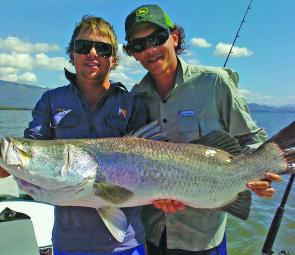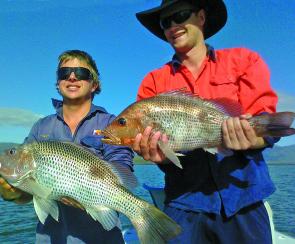It has been an awesome start to the winter barra campaign this year with plenty of fish in the 90cm+ bracket falling to deep divers and live baits.
Many years ago anglers thought that winter barra were an impossibility, however back in the late 1980s in Townsville waters plenty of small school-sized fish were taken using live prawn around snags but the big specimens were rarely seen.
In recent years I have been studied the big fish behaviour patterns in waters cooler than 23ºC and have now fine tuned things – I can almost tell exactly when the bite will start and finish and approx how many bites we will get on particular days. We have always been able to predict bite periods but never so accurate for this time of year. The secrets I have stumbled on will go to the grave with me, some things are just a little too sacred to share openly.
Apart from the winter barra, this past month has also seen a great bite on the fingermark. This is another fish that was thought to be a hard task for winter fishing in the daylight hours. These days I catch just as many in winter as I do in summer.
Up in the Hinchinbrook Channel are many suitable areas to target fingermark; the trick is to fish deeper than you would normally do so for this species. In winter, they quite often forage when there is tidal movement so they don’t show up like traditional red blobs when they are stationary, so look in the deeper rubble holes and keep an eye out for similar echo returns, which maybe yellow or even greenish instead of red.
Most of the best fingermark spots up here are in the main channel but tidal flows can be a bit extreme at times and are best fished on the changing or neap tides.
Not too many offshore reports have filtered through recently, due to some rough conditions and the absence of anglers in the region now that the long weekends are finished. It’s still a very poor tourist season regardless of Cyclone Yasi impacts.
As for July, if the weather comes good then most of you will be best served offshore with the reef species and the Spanish mack around the inner reefs and islands. Cobia will also make an appearance on the inshore seagrass beds on the making tides up to the moon. On the run-out tide in Missionary Bay should be a good place to look in anywhere from 3-5m of water, but you must sit the tide out and use a berley trail with some drifted unweighted pillies out in the current.
For lure casters, there should also be a lot of small barra around the mudflat drains in the last two hours of the run-out tides. Don’t bother too much trying to work out the big barra as you can leave them for me and my clients, he he! If you would like to book a trip you can get me on 0418 538 170.
Reads: 2830
Reggie Lawrence with one of five 93-96cm winter barra he caught recently.

Trent Palmer and Simon Orford with Trent’s PB winter barra.

Trent and mate Jacob Denman with two out of nine decent winter fingermark for the session.




